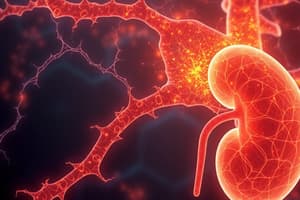Podcast
Questions and Answers
What is the primary function of Parathyroid Hormone (PTH)?
What is the primary function of Parathyroid Hormone (PTH)?
- Regulating vitamin D levels
- Regulating blood pressure
- Regulating blood sugar levels
- Regulating calcium and phosphorus levels in the blood (correct)
What happens to calcium levels in the blood when PTH is released?
What happens to calcium levels in the blood when PTH is released?
- Remains constant
- Varies depending on the time of day
- Increases (correct)
- Decreases
What is the effect of PTH on phosphorus reabsorption in the kidneys?
What is the effect of PTH on phosphorus reabsorption in the kidneys?
- Decreases it (correct)
- Has no effect
- Varies depending on the individual
- Increases it
What is the response of the kidneys to PTH?
What is the response of the kidneys to PTH?
What is the feedback mechanism that occurs when calcium levels are high?
What is the feedback mechanism that occurs when calcium levels are high?
What is the effect of PTH on bone tissue?
What is the effect of PTH on bone tissue?
Flashcards are hidden until you start studying
Study Notes
Calcium and Phosphorus Regulation by Kidneys: Parathyroid Hormone Regulation
Parathyroid Hormone (PTH)
- Produced by the parathyroid glands
- Regulates calcium and phosphorus levels in the blood
- Released in response to low calcium levels
PTH Regulation of Calcium
- Increases calcium reabsorption in the kidneys
- Stimulates calcium transport in the proximal convoluted tubule
- Enhances calcium absorption in the distal convoluted tubule
- Stimulates bone resorption, releasing calcium into the bloodstream
- Activates osteoclasts, breaking down bone tissue
PTH Regulation of Phosphorus
- Decreases phosphorus reabsorption in the kidneys
- Inhibits phosphorus transport in the proximal convoluted tubule
- Increases phosphorus excretion in the urine
- Stimulates phosphorus release from bone, reducing phosphorus levels in the blood
Feedback Mechanisms
- Negative feedback loop: high calcium levels inhibit PTH secretion
- Positive feedback loop: low calcium levels stimulate PTH secretion
Kidney Response to PTH
- Increases calcium reabsorption and phosphorus excretion in response to PTH
- Regulates calcium and phosphorus levels in the blood through PTH-mediated mechanisms
Parathyroid Hormone (PTH) Regulation
- PTH is produced by the parathyroid glands and regulates calcium and phosphorus levels in the blood
- Released in response to low calcium levels, PTH plays a crucial role in maintaining calcium homeostasis
Calcium Regulation by PTH
- PTH increases calcium reabsorption in the kidneys by stimulating calcium transport in the proximal convoluted tubule and enhancing calcium absorption in the distal convoluted tubule
- PTH stimulates bone resorption, releasing calcium into the bloodstream by activating osteoclasts, which break down bone tissue
Phosphorus Regulation by PTH
- PTH decreases phosphorus reabsorption in the kidneys by inhibiting phosphorus transport in the proximal convoluted tubule
- PTH increases phosphorus excretion in the urine, reducing phosphorus levels in the blood
- PTH stimulates phosphorus release from bone, further reducing phosphorus levels in the blood
Feedback Mechanisms
- High calcium levels inhibit PTH secretion through a negative feedback loop
- Low calcium levels stimulate PTH secretion through a positive feedback loop
Kidney Response to PTH
- The kidneys respond to PTH by increasing calcium reabsorption and phosphorus excretion
- The kidneys regulate calcium and phosphorus levels in the blood through PTH-mediated mechanisms
Studying That Suits You
Use AI to generate personalized quizzes and flashcards to suit your learning preferences.




